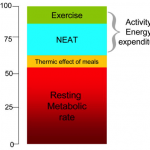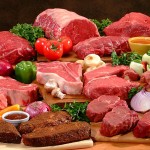Welcome Back!!
Today we look at the 4 components of metabolism and how you can manipulate them to drop fat…
The Four Components of Your Metabolism:
Human metabolism is basically made up of four parts which combine to become our metabolic rate.
In any 24-hour period, our bodies ‘burn’ a given number of calories – this is called TDEE (Total Daily Energy Expenditure) or TEE (Total Energy Expenditure) – and this calorie / kilojoule burn is a measure of our body’s metabolic rate.
Your body’s metabolic rate (or TDEE) can be divided into four components:

Broadly speaking this is our metabolism...
Your Basal Metabolic Rate (BMR) is the number of calories your body burns while sleeping. Many factors can affect your BMR, including your age, health, stress level, and even the temperature of your environment. Your BMR, like all of your metabolic elements, decreases as you age. This means that it is harder for your body to burn calories and harder for you to lose fat the older you get. Increases in BMR are possible but this increase comes about through the actions of the next three components.
Your Resting Metabolic Rate (RMR) is a measure of the amount of calories / kilojoules your body burns at rest just to maintain it. The RMR accounts for 50-80 per cent of the energy we use doing ‘nothing’ whilst being awake.
In reality even when lazing around or just chilling out watching DVDs our body’s metabolism is still active. The total lean mass of our body, especially muscle mass, is largely responsible for the RMR.
So, anything that reduces your lean mass will reduce your RMR. RMR is the largest part of our total metabolism and accounts for 50 – 80% of the calories burnt in a day. This is why it’s so important to preserve lean tissue mass when you are working at shedding fat – your RMR is your main metabolic ‘furnace’. This means that exercise that encourages the preservation or growth of muscle is a must if we are to get the RMR working for us.
Your RMR is also affected by the simple act of eating which leads us to…
The Thermic Effect of Food (TEF) – this is covered in depth in the Lose 20 in 30 Fuel Manual but essentially TEF is a measure of the energy that your body uses to eat, digest and metabolise food.
Really it is the second law of Thermodynamics at work – converting energy from one form to another is never 100% efficient. This means that to release the energy in food we need to expend energy to ‘fuel’ this process.
TEF accounts for about 5-10 per cent of our energy use. Our RMR rises after we eat because of the energy

Maximise your TEF by eating lean proteins with low GI, high fobre carbs...
we use to eat, digest and process the food we’ve just eaten. The rise occurs soon after we begin to eat and peaks two to three hours later. The RMR rise can range from between 2-3 per cent to up to 25-30 per cent, depending on the size of the meal and the types of foods eaten.
For example:
- Fats – generally raise the RMR about 4 per cent
- Carbohydrates – can raise RMR up to 6 per cent
- Proteins – usually raise RMR up to 30 per cent
Unfortunately, since our body can store excess dietary fat pretty much directly as body fat, there is no need to convert it, so eating fat generates virtually no thermic effect at all.
Another factor that affects your TEF is your body composition. Basically the leaner you are the higher your TEF is. Columbia University ran a trial with a group of lean individuals and a group of obese ones and then tested their TEF at rest, during exercise and after exercise.
Compared to the obese group the lean group TEF was:
- 70% Higher at rest
- 316% Higher during exercise
- 175% Higher after exercising.
This is proof that shedding fat helps to recondition your metabolism which in turn helps keep you lean.
The Thermic Effect of Activity (TEA) – this is the amount of energy that we use during physical activity – and for in a ‘normally’ active person, this accounts for 15 – 40 per cent of our daily energy use depending upon the type of activity and its metabolic ‘cost.’ The range in effect is because of the variance in the amount of and type of activity we can indulge in.

This will up your TEA no end!!!
TEA includes all physical activity whether conscious exercise, climbing stairs, brushing your teeth, shivering in the cold or even fidgeting. At rest, by themselves, our muscles can account for about 20 per cent of our total energy expenditure. Not too shabby but during strenuous exercise, our rate of muscular energy expenditure can increase 50-fold or more. During heavy physical exertion, our muscles can burn through as much as 3,000kJ per hour. This is the only type of energy ‘burn’ that we can directly control – the energy used during conscious exercise.
After food intake, movement and conscious exercise are the final keys to fat loss and a reconditioned metabolism.
It is here where we can have the greatest immediate effect on our metabolism. The metabolic effects of food work hand in glove with conscious exercise, but nothing revs up your metabolism in the short term as much as vigorous exercise. The intensity, type, frequency and duration of any activity will have an effect on metabolism. We need to choose wisely and use those which have the highest metabolic cost and the create the strongest afterburn.
I can’t stress it enough – the effect of your TEA on your metabolism will vary depending on your individual activity level each day. The more you move the more you burn. The smarter you move the even more you burn.
A sedentary person will require fewer calories to maintain their current body composition than a busy worker on a construction site or someone who uses metabolic resistance training at least 3 times a week.
Of these 4 metabolic components we are most interested in and most able to directly positively affect the TEF & our TEA. Once get these 2 components working for us, our RMR & BMR will both rise, and our set points can be altered. More importantly our body composition can shift.
Okay so how do we use these components? That’s the subject of the next post…
Take Away: By raising your RMR we can become leaner and stay that way – the 2 ways we can do this most easily are by manipulating our TEA & the TEF.





